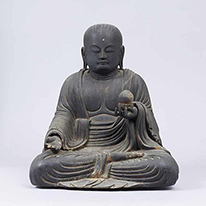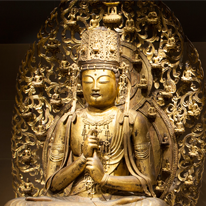Past Exhibitions
- Deities of Buddhist Hell: King Enma and Jizō
- June 13, 2017 - September 3, 2017
The Obon or Bon Festival is a familiar Japanese summertime custom, but its name is originally derived from the Sanskrit ullambana and its roots lie in India. It is an occasion to appease the souls of ancestors, but it is also said to be the day that the lid is lifted from the cauldrons of Hell. The King of Buddhist Hell is Enma, who is also the judge of the afterlife. Enma is also derived from India, specifically the Hindu god of the underworld Yama. He was syncretized with Taoist deities in China and in Japan became the leader of the Ten Kings (Judges) of Hell. In addition to statues of these ten rulers, on loan from Jōnen-ji Temple in Kamo-cho, Kizugawa, this gallery features images of the Bodhisattva Jizō (derived from the Indian deity Kshitigarbha), who rescues souls from Hell. We are sure these powerful depictions of the fearsome deities of Buddhist Hell will send shivers up many spines!
- Japanese Sculpture
- June 13, 2017 - July 23, 2017
Before the Edo period, almost all Japanese sculpture was religious in nature. Buddhist sculptures were produced in Japan from the time Buddhism took hold in the seventh century, but the icons they represented came from India by way of China, bringing with them the influence of those countries.
One of the distinctive characteristics of Japanese sculpture is its use of wood as a primary material. Because sculptures were made of wood, various construction styles and techniques were developed, including joint-block construction (yosegi zukuri) and inlaid crystal eyes.
Japanese Buddhist sculptures from various historical periods exemplify the repeated waves of influence from the Asian mainland and subsequent Japanese innovations, leading to a rich variety of sculptural styles.













